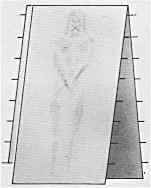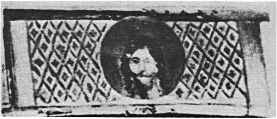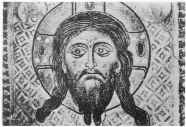

 |
| Next
2 foldings, producing an image of the Face only |
First folding, in half
The images Left and Above illustrate Ian Wilson's Theory of how the Shroud was folded for most of its history, disguising the fact that it was a full lenth gravecloth, and appearing instead to be a portrait of only a Face, the Mandylion.
In the Jewish religion graveclothes were regarded as unclean, and they were not to be touched. This taboo may explain the need to 'disguise' the Shroud at the beginning of its history.
Early Art Supports this Theory
Below are three artists' copies of the mandylion, all pre-1204 - the date when the Mandylion disappeared from Constantinople. They show a stretched taut appearance, the apparent trellis cover and (in the case of the Spas Neredisa example) what seem to be nails to which the cloth's fringe is attached.



To read about Ian Wilson's theory of how the Mandylion became the Holy Shroud, see 'The Turin Shroud', Part IV - 'Towards a History - The Shroud and the Mandylion'.